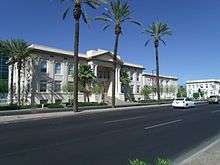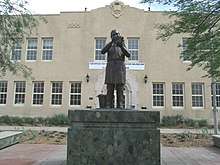Phoenix Union High School District
The Phoenix Union High School District is a high school-only school district in Phoenix, Arizona, United States. It is one of five high school-only districts in the Phoenix area.
| Phoenix Union High School District | |
|---|---|
 | |
| Address | |
4502 N. Central Ave. Phoenix , Arizona | |
| Information | |
| Type | Public secondary school |
| Motto | "Preparing Every Student for Success in College, Career and Life" |
| Established | 1895 |
| Faculty | 2,777 |
| Grades | 9-12 |
| Enrollment | 27,031 |
| Website | |
Overview
The school district serves students within a 220 square miles (570 km2) area of Phoenix, and 27,761 students are enrolled within its 20 schools.[1] Its boundaries are largely coextensive with what was the city of Phoenix prior to the 1960s.
The school is a minority-majority district, with 81.7% of its students being identified as "Hispanics",[2] and 52.4% of its students speaking Spanish at home.[1] In all, 71 languages have been identified as primary home languages.[1]
The district employs 2,777 people, with 1,617 of them being teachers.[1]
The school district has no elementary or middle schools, and as such, it has identified 13 elementary school districts as its Partner Elementary Districts, with students who enroll with those districts being fed into PUHSD's high schools.[3]
History

The school district's roots lie with the opening of Phoenix Union High School in 1895. In that same year, Arizona's Territorial Legislature[4] passed a law that allowed districts with at least 2,000 residents to form high schools.[5]
Phoenix Union High School first opened with four classrooms and 90 students, on the second floor of an elementary school building, but eventually moved into its final location, near 7th Street and Van Buren. The school campus was a former mansion, and was chosen at the time because it was located in a residential area, bordered in part by two arterial streets.[6] PUHS also affected later developmental patterns in the area.[6]
Phoenix College
In 1920, Phoenix Union High School District opened Phoenix College as Phoenix Junior College,[7] after consultation with University of Arizona and the designing of a two-year curriculum.[8] The school, however, was considered to be extra-legal, as no laws authorized its existence. That changed in 1927, after the Arizona State Legislature authorized and legalized the creation and maintenance of Junior Colleges in Arizona.[8] Phoenix Union High School District would vote to transfer Phoenix College to the Maricopa County Community College District in 1963.[8]
Segregation of African American students

Beginning in the late 1910s, Phoenix Union High School District began segregating its White and African American students. While segregation of elementary schools in Arizona was mandated, segregation of high schools was never required under Arizona law.[9]
In 1918, a "Department for Colored Students" that was established at a rear room of Phoenix Union High School's Commercial Building, with one teacher.[5] The school's African American students were then housed in two small cottages that was separated from the PUHS campus by an irrigation ditch.,[5] and later placed at a rented house on 9th Street and Jefferson.[5]
A plot of land that would later become the Phoenix Union Colored High School (later George Washington Carver High School) was purchased in 1925.[5] The site, a former four-acre landfill that was surrounded by warehouses,[10] drew protests over safety and sanitary concerns.[5] The school, however, was opened in 1926, and was the only one ever built exclusively to serve African American high school students in Arizona.[11]
The school was closed 1954,[7] a year after a judge at the Maricopa County Superior Court ruled school segregation in Phoenix high schools was unconstitutional, in the case Phillips vs. Phoenix Union High Schools and Junior College District.[12] PUHS, along with Carl Hayden High School and South Mountain High School, took on the bulk of the school district's African American students after desegregation.[5]
To this day, Phoenix Union High School District's website makes few references to the school's segregated past, merely stating that Carver High was built to accommodate the district's African American population, and stating that the school closed, following integration.[7]
Expansions
Until 1926, Phoenix Union High School was the school district's only school. By 1939, PUHS' student population reached 5,219,[13] and North High School, the first school not built for the purpose of segregation, opened its doors.[7]
Between 1949 and 1957, five additional high schools were built: Camelback, Carl Hayden, Central, West, and South Mountain.[7] Those were followed by Alhambra, East, and Maryvale in the 1960s.[7] Trevor G. Browne opened its doors in 1970s, along with alternative schools Bostrom High and Desiderata Program[7]
Changes
The racial makeup of Phoenix Union High School District schools began to change during the 1950s and 1960s. PUHS' African American and Hispanic population increased during those two decades,[14] and by 1970, the school's White population fell to 19.3% of the student body. Despite that rise, PUHS' ethnic minorities had little say in determining and conducting education at the school.[14] Meanwhile, violence between the school's Hispanic and African American population eventually played a large role in everyday school life, with each side blaming the other side.[14]
A riot brought on by racial tensions also happened during the 1970s at South Mountain High School.[15]
Closures and lawsuits
In the 1980s, Phoenix Union High School District's board voted to close North High, PUHS, and East High, and West High, due to declining enrollment.[7]
As a result of the closures, two lawsuits were filed, accusing the Phoenix Union High School District of discriminating against ethnic minorities and low-income students by closing schools in their neighborhoods, in addition to unfair resource allocations.[16]
An Office for Civil Rights investigation also found that the school district had an open enrollment policy that, while designed to alleviate school overcrowding, resulted in racial imbalance.[17] The school district, according to the investigation, was fully aware of the policy's impact, and, despite numerous recommendations, chose not to take action of the matter.[17]
The lawsuits were later consolidated into the Castro v. Phoenix Union High School District lawsuit.[16] Eventually, a federal judge ruled against the school district.[18] A consent decree followed the ruling, which resulted in the reopening of North High, as well as, among other things, the establishment of magnet programs across the district, continued summer school programs, increased transportation options for students, and the building of two more high schools.[16]
1990s and 2000s
In 1999, Cesar Chavez High School opened its doors, becoming the first Phoenix Union High School to be built in 27 years.[7] Another comprehensive high school, Betty H. Fairfax High School, opened in 2007.[7]
The 2000s also saw the building of a number of specialty schools. Suns-Diamondbacks Education Academy (since renamed Linda Abril Educational Academy), a school for at-risk students, was established in 2001.[19] Franklin Police and Fire High School, a first-of-its-kind public safety-oriented school, opened in 2007.[7] Bioscience High opened in 2006.[7]
2010s
The district was considering whether to open another high school as other high schools were above capacity.[20]
Schools
Comprehensive schools
- Alhambra (Phoenix) - opened 1961
- Bioscience (Phoenix) - opened 2006
- Trevor Browne (Phoenix) - opened 1972
- Camelback (Phoenix) - opened 1954
- Central (Phoenix) - opened 1957
- César Chávez (Laveen) - opened 1999
- Betty Fairfax (Laveen) - opened 2007
- Carl Hayden (Phoenix) - opened 1957
- Maryvale (Phoenix) - opened 1963
- North (Phoenix) - opened 1939
- South Mountain (Phoenix) - opened 1954
- Metro Tech (Phoenix) - opened 1985
Small and alternative schools
- Linda Abril Educational Academy (Phoenix) - opened 2001
- Bostrom High School (Phoenix) - opened 1976
- Desiderata Program (Phoenix) - opened 1977
- Phoenix Union Bioscience High School (Phoenix) - opened 2006
- Franklin Police and Fire High School (Phoenix) - opened 2007
Former
- George Washington Carver High School (1926-1954)
- East High School (1964-1982)
- Phoenix Union High School (1912-1982)
- Phoenix Union Cyber High School
- West High School (1949-1983)
Feeder elementary school districts
- Alhambra Elementary School District
- Balsz Elementary School District
- Cartwright Elementary School District
- Creighton Elementary School District
- Isaac Elementary School District
- Laveen Elementary School District
- Madison Elementary School District
- Murphy Elementary School District
- Osborn Elementary School District
- Phoenix Elementary School District
- Riverside Elementary School District
- Roosevelt Elementary School District
- Wilson Elementary School District
References
- "District Information / District Profile". Phoenix Union High School District. Retrieved 3 December 2017.
- See Hispanic–Latino naming dispute for details of an ongoing dispute on the naming of US inhabitants who are of Latin American or Spanish origin.
- "District Information / Partner Elementary Districts". Phoenix Union High School District. Retrieved 3 December 2017.
- Arizona did not achieve statehood until 1912.
- "Staff Report: Z-72-16-8" (PDF). City of Phoenix. 10 November 2016. Retrieved 30 November 2017.
- "National Register of Historic Places Nomination Form for Phoenix Union High School Historic District" (PDF). National Park Service. 1982. Retrieved 3 December 2017.
- "District Information / History". Phoenix Union High School District. Retrieved 3 December 2017.
- "Phoenix College - Historical Timeline - 1920 - 2015". Phoenix College. Retrieved 3 December 2017.
- Finn, Elizabeth (July 1998). "The Struggle for Civil Rights in Arizona". State Bar of Arizona. Archived from the original on 4 March 2016. Retrieved 3 December 2017.
At mid-century, state law mandated segregation in the elementary schools but made it optional in the high schools.
- Arroyo Rodriguez, Nadine (18 October 2013). "Did You Know: George Washington Carver High School Has Rich History". KJZZ-FM. Retrieved 3 December 2017.
- African American Historic Places. John Wiley & Sons, Inc. 1994. p. 108. Retrieved 30 November 2017.
- "Frederick C. Struckmeyer". Arizona Legal Legacies Project. Retrieved 30 November 2017.
- "Arizona High School Enrollment Figures (1912-2005)" (PDF). aiaonline.org.
- Luckingham, Bradford (1989). Phoenix: The History of a Southwestern Metropolis. Tucson: The University of Arizona Press. p. 217.
- Fitzpatrick, Tom (17 November 1994). "A Process is Due At South Mountain High". Phoenix New Times. Retrieved 27 November 2017.
When Roberto Frietz, now 39, was a student at South Mountain High School in the 1970s, a riot brought on by racial tensions broke out at the school.
- "Phoenix Union High School District Desegregation Funding: History and Impact" (PDF). Morrison Institute for Public Policy, Arizona State University. November 2017. Retrieved 3 December 2017.
- "Performance Audit - Phoenix Union High School District" (PDF). Arizona Auditor General. 30 December 2009. p. 45. Retrieved 3 December 2017.
- Creno, Cathryn (1 July 2014). "17 historic schools in metro Phoenix". The Arizona Republic. Retrieved 3 December 2017.
- "Linda Abril Educational Academy / Homepage". Linda Abril Educational Academy. Retrieved 29 November 2017.
- Carlson, Mark (2018-09-19). "Phoenix district looking at plans for new schools due to overcrowding". KTAR. Retrieved 2019-11-06.